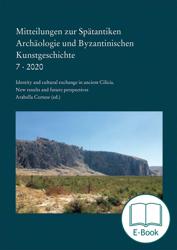The publication on Rough Cilicia "Identity and cultural Exchange in Ancient Cilicia: New Results and Future Perspectives" combines the results of a workshop held at the Ludwig-Maximilians-University of Munich in May 2018. It contains a series of individual studies that reveal the uniqueness of Cilicia as a cultural landscape shaped by geography and regional interaction.
To this end, the expertise of scientists who have carried out important research in Cilicia or Isauria over the last ten years will be brought together. By providing a diachronic overview of archaeological finds from the Hellenistic period to Late Antiquity, this volume promotes comparative analyses between the rough and the flat Cilicia. Results of archaeological regional studies, which too often remain isolated, are combined to examine the factors that contributed to acculturation processes in Cilicia and that shaped the local identity of the region.
Identity and Cultural Exchange in Ancient Cilicia—New Results and Future Perspectives is the results of a conference held at the University of Munich in 2018. It assesses the state of knowledge regarding Cilicia between the Roman period and Late Antiquity. The diverse array of studies in this volume contribute to the reappraisal of the region as a unique cultural locale.
What must we analyze in order to understand the identity of a multifaceted region, which contains manifold landscapes, multicultural communities, and displays influences from several cultures, as Cilicia did in Late Antiquity? In answer to this main question, an international team of scholars from various research areas, linked by sustained work in Cilicia, present the latest results of their excavations or research.
The volume contains eight illustrated articles that deal with important topics in research on Cilicia, which are arranged chronologically from the Hellenistic period to Late Antiquity.
The first two articles analyze the emergence of the phenomenon of urbanization in the whole region and the birth of coin production and circulation in the fervent Cilicia Tracheia. The following two chapters consider the numerous epigraphic sources recently found in Cilicia, both in buildings and in funerary contexts, in order to show how the migration processes and cultural interchanges made the region a crossroads for peoples and cultures.
How did the advent of Christianity contribute to strengthening the role of Cilicia as a vital cultural region and a place visited by international visitors?
The last four contributions analyze the importance of the region in Late Antiquity through its sacred buildings. The archaeological evidence brought to light in excavation campaigns conducted continuously since 2011 in the city of Olba and its monastery highlights the continuity of use of the city in the Christian period and its relationship with the nearby cities.
How did the city of Korykos, a renowned city harbor in Late Antiquity, become a place of veneration for one or more local saints? This question is addressed by the penultimate article, which re-evaluates the importance of the city in Late Antiquity through careful analysis of some inscriptions found in the necropolis of Korykos and of an outstanding basilica, the architectural layout of which suggests a particular function.
The final contribution applies the sociological concept of gathering to the renowned pilgrimage site of Saint Thekla at Meryemlik in order to show how architecture and landscape contribute to the increase of pilgrimage experience of a Late Antique site.
This volume represents a significant contribution to the history and archaeology of the region, offering an updated overview of recent studies on Cilicia (many of which were published only in Turkish) and a survey of the Cilician past that can be considered the basis for future studies.
„This slim volume of just over 150 pages contains eight papers on the archaeology of Cilicia and ısauria in southern Asia Minor, the product of a conference held in Munich in 2018. ıt is a nicely produced volume, with a very short forward and introduction, plentiful black and white illustrations of good quality at the end of each paper, and no conclusion or index (not these are needed). The chronological focus is mostly on late antiquity, while spatially the emphasis is on the central part of Cilicia between the modern cities of Silifke and Ayaş (ancient Seleucia-ad-Calycadnum and Elaiussa/Sebaste). As a whole the volume reflects the international nature of current fieldwork in Turkey with three Turkish and five central European papers, written in either English or German. (...) Overall, this is a useful collection for those whose research focuses on classical Cilicia, published swiftly and well-edited. However, only reviewers seem likely to read a physical copy from cover to cover, while others will access individual articles online.“
Von Hugh Elton
In: sehepunkte 21 (2021), Nr. 2 [15.02.2021], URL:
http://www.sehepunkte.de/2021/02/34391.html
Arabella Cortese (*1983) is a research assistant at the University of Regensburg.
She studied Medieval Archaeology at the University of Pisa. She completed her master's degree with a thesis on the architectural development of the Church of S. Andrea in Foriporta in Pisa, a crucial building for the history of the Maritime Republic during the middle centuries of the Middle Ages. After a period of research at the University of Malta, Cortese has been pursuing her dissertation project at LMU Munich in Late Antique and Byzantine Art History, and since 2017 she has been a research assistant in the GRK 2337 “Metropolität in der Vormoderne.”
Cortese’s research deals with the sacral topography of Cilicia. Through an archaeological analysis of the main pilgrimage sites and religious buildings of the region and the bounded study of the literary sources, the project aims to reconstruct the sacral landscape of Cilicia during Late Antiquity. Some recent theoretical approaches frame her main thesis, namely the concept of collective memory (J. Assmann, P. Nora) and the importance of the cityspace (E. Soja).
Research interests: the early Christian cult of saints and martyrs; the city in Late Antiquity (with a focus on Asia Minor); pilgrimage routes and places of pilgrimage in Late Antiquity; urban space, memorial sites and sacral landscape in Late Antiquity.


 Sample
Sample